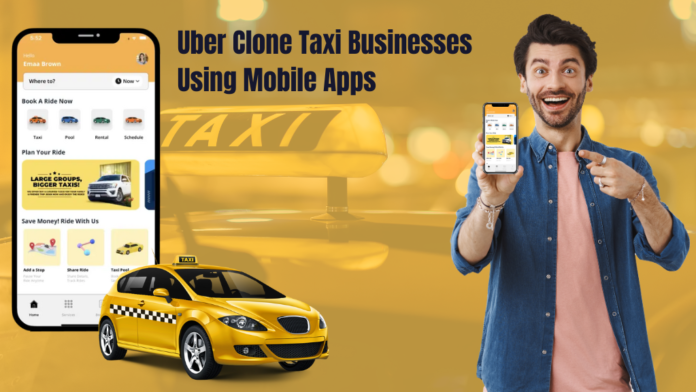Last Updated on January 24, 2024 by Asfa Rasheed
The past few years have been witness to a shift in consumers hailing rides from an Uber Clone app. In the last decade, the taxi market has turned upside-down for conventional taxi fleets.
With the advent of apps that allows booking ride from anywhere, these businesses are shifting to on-demand taxi booking.
But one can say that today, even a private taxi company cannot find fresh ground or thrive without an app. Luckily, Uber Clone Apps has paved the way for entrepreneurs to stabilize their growth and provide safety to their passengers.
Table of Contents
Introduction
Uber has set the standard for the taxi startup market. But before the internet, on-demand transportation solely relied on calling and booking, which was pretty neat at the time.
Though it is done today as well, consumers now want more for themselves and less for others. With the power they have, whether it is day or night, in a remote location, a taxicab is available anytime. With a few swipes and touch, they can hail a taxi from anywhere they want to at anytime they like.
Let’s start comparing both the models of today’s taxi services and dive deeply into where each stands.
Market Advantages
The entire concept of a taxi came into being by giving stability to the driver.
Making money from helping a fellow person in need became the business model that is making billions worldwide. One can argue that there are two different markets for the present ride-hailing situation. But they are on the same side of the coin. The difference comes when consumers request a ride and which medium they choose to do so.
Because when we stop a taxi in the middle of the street, it is generally done without the need for an app. However, when we need a taxicab to come to the location of our preference, there is nothing better than requesting it through a mobile app.
Here, the limitations diverge to different features, from online payment to real-time tracking. Currently, online and offline bookings separate the taxi market into two different categories. However, online bookings are driving the taxi market with the simple integration of a dedicated taxi app.
A study found that when Uber introduced the ‘shared economy’ model, it was met with widespread protests. But in reality, the number of self-employed drivers grew by 50% during the first six months in the US. In addition, having a smartphone for easy access gave an extra boost for further market penetration.
At its peak, Uber reached a staggering 75% market share within the rideshare industry in the US. As other businesses followed, the market started to centralize, eventually lowering the cost of the rides. But overall, the story remained the same, only with a small change of platform.
Now, people prefer Uber rather than conventional taxis, as it is safer and gives more power to the passenger.
User Experience
The fact that you are ordering a taxicab to the place you want really sets the tone for the experience you are going to have.
Although the travel stays the same inside the vehicle, the technology behind the physical change really gets you thinking. As mentioned earlier, during the night or from a remote location, finding a taxicab is generally hard. The experience really changes when, out of the blue, within minutes, there exists a vehicle that is ready to pick you up and drop you off.
In the midst of all this, owning a smartphone has become crucial to staying relevant. Furthermore, the way that multiple payment options have given on-the-spot choices for different methods is a game changer as well. The concept of a taximeter has been barren and obsolete and considered ancient just to experience it the way we did before.
It is a rapid change that has forced the conventional driver to either protest or become a part of it.
But one thing is for certain. Uber Like Apps are sure to cover every place they can manage before the local taxi service starts to.
The World Is Going Digital
Although Uber has been banned in many countries, Uber-like business models are taking their place quickly.
It can be said that the solutions have become more intensive to cater to business ideas with far-reaching potential. In other words, by showing a new solution, businesses are treating each city as an individual project. However, this doesn’t mean the convention taxicabs have lost their powers.
They are equally important as Uber. To keep simplicity and traditional norms as a basic pillar, most of the drivers have opted for hybrid models.
That is, taking new requests from the app as well as from the road.
Rise of Uber Clone Taxi Businesses
There has been a sharp incline in on-demand taxi service providers due to the rapid growth of Uber. With an aim to capture the taxi market without owning any vehicles, many businesses are eyeing the same growth with innovations. This has led to the emergence of a number of startups that have designed and developed their own apps, like Uber.
One key takeaway from all this is cutting the development cost and instantly white-labeling the Uber Clone for quick launch. The thought process put into this model is not developing the app on your own. It takes months to integrate dozens of features.
Instead, the driver and passenger-facing apps are simply bought from an established app development firm that offers re-branding services. Moreover, this allows the business to easily enter the market. In addition, it also works according to the laws and regulations that Uber ignored in the past.
In other words, mistakes made by Uber to fight legal action can be easily prevented with smart business decisions. Even after the launch, a lot of marketing and advertising strategies can be worth investing in from the start.
Seeing this change, many businesses have since taken this easy road and have made profits from different revenue models. Generally, it takes around 1-2 weeks to launch the pre-built uber clone app, which makes the investment profitable. Moreover, you can further customize the Uber Clone app according to the target audience you have in mind.
With both time and money saved during this process, you can easily contribute from your end.
Conclusion
Digital innovation and business transformation are full of risks and opportunities. In this digital era, customers are everywhere, and mobile apps are the future.
While it is as important as ethically moving forward, cutthroat competition can set you back if you are not willing to embrace innovation and diversity simultaneously. With the help of an Uber Clone, you can stop worrying about adjusting the budget for hiring app developers. Get a website and admin panel along with driver and passenger-facing apps with similar features as Uber, if not better.
Prevent your conventional taxi service from becoming outdated, slowly fading into the abyss, and losing control of the changing market.



























